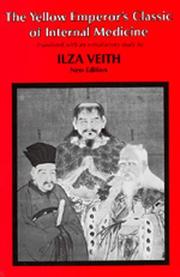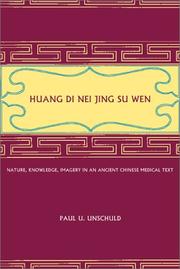| Listing 1 - 6 of 6 |
Sort by
|
Book
ISBN: 0520266986 9780520266988 Year: 2011 Publisher: Berkeley : University of California Press,
Abstract | Keywords | Export | Availability | Bookmark
 Loading...
Loading...Choose an application
- Reference Manager
- EndNote
- RefWorks (Direct export to RefWorks)
History, Ancient. --- Medicine, Chinese Traditional. --- Medicine, Chinese --- Su wen. --- S21/0300 --- China: Medicine, public health and food--Chinese medicine: general --- Huang-ti nei ching su wen --- Nei ching su wen --- Nei jing su wen --- Soo wăn --- Hwâng tê soó wăn --- Hwangje naegyŏng somun --- Huang-ti nei ching. --- Huangdi nei jing. --- Somon --- Hoàng đé̂ nội kinh tó̂ vân

ISBN: 0520021584 Year: 1972 Publisher: Berkeley University of California press
Abstract | Keywords | Export | Availability | Bookmark
 Loading...
Loading...Choose an application
- Reference Manager
- EndNote
- RefWorks (Direct export to RefWorks)
Medicine, Chinese --- Médecine chinoise --- S21/0300 --- #SML: Joseph Spae --- China: Medicine, public health and food--Chinese medicine: general --- Médecine chinoise --- internal medicine --- 'Huang Ti Nei Ching Su Wên' --- philosophy --- Tao --- Yin and Yang --- the five elements and the system of numbers --- the celestial stems --- anatomical and physiological concepts --- diagnosis --- diseases of the 'Nei Ching' --- therapeutic Concepts --- acupuncture --- moxibustion --- the 'Ssu-k'u Ch'üan-shu' --- Wang Ping (762 A.D.) --- Kao Pao-hêng and Lin 1 (1078 A.D.)
Book
ISBN: 0520963245 9780520963245 Year: 2016 Publisher: Oakland, California : University of California Press,
Abstract | Keywords | Export | Availability | Bookmark
 Loading...
Loading...Choose an application
- Reference Manager
- EndNote
- RefWorks (Direct export to RefWorks)
The Yellow Emperor's Classic of Internal Medicine has become a landmark in the history of Chinese civilization. Written in the form of a dialogue in which the emperor seeks information from his minister Ch'I-Po on questions of health and the art of healing, it is the oldest known document in Chinese medicine. Ilza Veith's extensive introduction and monumental translation, first published in 1949, make available the historical and philosophical foundations of traditional practices that have seen a dynamic revival in China and throughout the West. A new foreword by Linda L. Barnes places the translation in its historic contexts, underlining its significance to the Western world's understanding of Chinese medical practice.
Medicine, Chinese --- Su wen. --- Huang-ti nei ching su wen --- Nei jing su wen --- Soo wăn --- Hwâng tê soó wăn --- Hwangje naegyŏng somun --- Huangdi nei jing. --- Somon --- Hoàng đé̂ nội kinh tó̂ vân --- Nei ching su wen --- Huang-ti nei ching. --- acupuncture. --- alternative medicine. --- china. --- chinese history. --- chinese medicine. --- doctor. --- eastern medicine. --- emperor. --- healing. --- health and wellness. --- health. --- healthcare. --- herbal remedies. --- history. --- integrative medicine. --- internal medicine. --- medicine. --- nonfiction. --- physician. --- physiology. --- preventative medicine. --- spirituality. --- taoism. --- yellow emperor.

ISBN: 0520233220 Year: 2003 Publisher: Berkeley (Calif.) : University of California press,
Abstract | Keywords | Export | Availability | Bookmark
 Loading...
Loading...Choose an application
- Reference Manager
- EndNote
- RefWorks (Direct export to RefWorks)
The 'Huang Di nei jing su wen,' known familiarly as the 'Su wen,' is a seminal text of ancient Chinese medicine, yet until now there has been no comprehensive, detailed analysis of its development and contents. At last Paul U. Unschuld offers entry into this still-vital artifact of China's cultural and intellectual past. Unschuld traces the history of the 'Su wen' to its origins in the final centuries B.C.E., when numerous authors wrote short medical essays to explain the foundations of human health and illness on the basis of the newly developed vessel theory. He examines the meaning of the title and the way the work has been received throughout Chinese medical history, both before and after the eleventh century when the text as it is known today emerged. Unschuld's survey of the contents includes illuminating discussions of the yin-yang and five-agents doctrines, the perception of the human body and its organs, qi and blood, pathogenic agents, concepts of disease and diagnosis, and a variety of therapies, including the new technique of acupuncture. An extensive appendix, furthermore, offers a detailed introduction to the complicated climatological theories of 'Wu yun liu qi '("five periods and six qi"), which were added to the 'Su wen' by Wang Bing in the Tang era. In an epilogue, Unschuld writes about the break with tradition and innovative style of thought represented by the 'Su wen.' For the first time, health care took the form of "medicine," in that it focused on environmental conditions, climatic agents, and behavior as causal in the emergence of disease and on the importance of natural laws in explaining illness. Unschuld points out that much of what we surmise about the human organism is simply a projection, reflecting dominant values and social goals, and he constructs a hypothesis to explain the formation and acceptance of basic notions of health and disease in a given society. Reading the 'Su wen,' he says, not only offers a better understanding
Medicine, Chinese --- Traditional medicine --- Médecine chinoise --- Médecine traditionnelle --- Su wen. --- S21/0300 --- Chinese medicine --- TCM (Medicine) --- Traditional Chinese medicine --- China: Medicine, public health and food--Chinese medicine: general --- Medicine, Chinese - Early works to 1800. --- Medicine, Chinese. --- Medicine, East Asian Traditional --- Medicine, Traditional --- Complementary Therapies --- Culture --- Therapeutics --- Anthropology, Cultural --- Analytical, Diagnostic and Therapeutic Techniques and Equipment --- Anthropology --- Social Sciences --- Anthropology, Education, Sociology and Social Phenomena --- Medicine, Chinese Traditional --- Medicine --- Health & Biological Sciences --- Medicine - General --- Medicine, Chinese Traditional. --- Médecine chinoise --- Médecine traditionnelle --- Huang-ti nei ching su wen --- Nei ching su wen --- Nei jing su wen --- Soo wăn --- Hwâng tê soó wăn --- Hwangje naegyŏng somun --- Huang-ti nei ching. --- Huangdi nei jing. --- Somon --- Hoàng đé̂ nội kinh tó̂ vân
Book
ISBN: 9781931483186 1931483183 Year: 2011 Publisher: Dunedin Three pines
Abstract | Keywords | Export | Availability | Bookmark
 Loading...
Loading...Choose an application
- Reference Manager
- EndNote
- RefWorks (Direct export to RefWorks)
S11/0740 --- S21/0500 --- China: Social sciences--Sexual life: general and before 1949 --- China: Medicine, public health and food--Public health, hospitals, medical schools, etc. --- Longevity --- Medicine, Chinese. --- Sex --- Sexual health --- History. --- Terminology. --- Su wen. --- Medicine, Chinese --- Gender (Sex) --- Human beings --- Human sexuality --- Sex (Gender) --- Sexual behavior --- Sexual practices --- Sexuality --- Sexology --- Hygiene, Sexual --- Hygiene, Social --- Sex hygiene --- Sexual hygiene --- Social hygiene --- Health --- Sex instruction --- Sexually transmitted diseases --- Chinese medicine --- TCM (Medicine) --- Traditional Chinese medicine --- Traditional medicine --- Life, Long --- Life extension --- Life span prolongation --- Long life --- Prolongation of life span --- Age --- Life spans (Biology) --- Old age --- History --- Terminology --- China: Medicine, public health and food--Public health, hospitals, medical schools, etc --- Huang-ti nei ching su wen --- Nei ching su wen --- Nei jing su wen --- Soo wăn --- Hwâng tê soó wăn --- Hwangje naegyŏng somun --- Huang-ti nei ching. --- Huangdi nei jing. --- Somon --- Hoàng đé̂ nội kinh tó̂ vân

ISBN: 1282759078 9786612759079 0520928490 1597346659 9780520928497 0585468583 9780585468587 0520233220 9780520233225 9781282759077 6612759070 9781597346658 Year: 2003 Publisher: Berkeley : University of California Press,
Abstract | Keywords | Export | Availability | Bookmark
 Loading...
Loading...Choose an application
- Reference Manager
- EndNote
- RefWorks (Direct export to RefWorks)
The Huang Di nei jing su wen, known familiarly as the Su wen, is a seminal text of ancient Chinese medicine, yet until now there has been no comprehensive, detailed analysis of its development and contents. At last Paul U. Unschuld offers entry into this still-vital artifact of China's cultural and intellectual past. Unschuld traces the history of the Su wen to its origins in the final centuries B.C.E., when numerous authors wrote short medical essays to explain the foundations of human health and illness on the basis of the newly developed vessel theory. He examines the meaning of the title and the way the work has been received throughout Chinese medical history, both before and after the eleventh century when the text as it is known today emerged. Unschuld's survey of the contents includes illuminating discussions of the yin-yang and five-agents doctrines, the perception of the human body and its organs, qi and blood, pathogenic agents, concepts of disease and diagnosis, and a variety of therapies, including the new technique of acupuncture. An extensive appendix, furthermore, offers a detailed introduction to the complicated climatological theories of Wu yun liu qi ("five periods and six qi"), which were added to the Su wen by Wang Bing in the Tang era. In an epilogue, Unschuld writes about the break with tradition and innovative style of thought represented by the Su wen. For the first time, health care took the form of "medicine," in that it focused on environmental conditions, climatic agents, and behavior as causal in the emergence of disease and on the importance of natural laws in explaining illness. Unschuld points out that much of what we surmise about the human organism is simply a projection, reflecting dominant values and social goals, and he constructs a hypothesis to explain the formation and acceptance of basic notions of health and disease in a given society. Reading the Su wen, he says, not only offers a better understanding of the roots of Chinese medicine as an integrated aspect of Chinese civilization; it also provides a much needed starting point for discussions of the differences and parallels between European and Chinese ways of dealing with illness and the risk of early death.
Medicine, Chinese Traditional. --- Medicine, Chinese --- Chinese Traditional Medicine --- Traditional Chinese Medicine --- Traditional Tongue Assessment --- Traditional Tongue Diagnosis --- Chinese Medicine, Traditional --- Chung I Hsueh --- Traditional Medicine, Chinese --- Zhong Yi Xue --- Hsueh, Chung I --- Tongue Assessment, Traditional --- Tongue Diagnoses, Traditional --- Tongue Diagnosis, Traditional --- Traditional Tongue Assessments --- Traditional Tongue Diagnoses --- Acupuncture Therapy --- Medicine, Kampo --- Su wen. --- Huang-ti nei ching su wen --- Nei ching su wen --- Nei jing su wen --- Soo wăn --- Hwâng tê soó wăn --- Hwangje naegyŏng somun --- Huang-ti nei ching. --- Huangdi nei jing. --- Somon --- Hoàng đé̂ nội kinh tó̂ vân --- acupuncture. --- alternative medicine. --- anthropology. --- chinese culture. --- chinese history. --- chinese medicine. --- disease. --- doctors. --- eastern medicine. --- environmental conditions. --- five agents doctrines. --- folk medicine. --- health and wellness. --- health care. --- health. --- history of medicine. --- holistic medicine. --- huang di nei jing su wen. --- human health. --- illness. --- medicine. --- nonfiction. --- pathogens. --- physicians. --- qi. --- social science. --- su wen. --- traditional medicine. --- wang bing. --- wu yun liu qi. --- yin yang.
| Listing 1 - 6 of 6 |
Sort by
|

 Search
Search Feedback
Feedback About
About Help
Help News
News